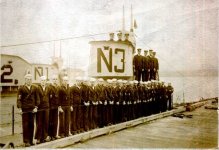Sneaks":2etxti9m said:
I also have photos (somewhere around here) of a boat of similar vintage that went aground off the Oregon/Washington coast. Pop's "sea story" was that they simply cut it apart, trucked it up to Seattle and put it back together again. True story, though I don't remember any info about it.
The photos I have are of the boat "ankle deep" in sand with lines leading ashore.
Don
Don, is this your boat? Couldn't find anything off oregon/washington.
Online Library of Selected Images:
-- EVENTS -- The 1910s -- 1916-1917
Stranding of USS H-3 and USS Milwaukee, and salvage of USS H-3, December 1916 - April 1917
On the morning of 14 December 1916 four U.S. Navy vessels were en route to visit the northern California city of Eureka. The three submarines, H-1, H-2 and H-3, and their tender, the monitor Cheyenne, had come down the West Coast in frequently foggy weather, and now had to negotiate heavy waves to enter the shelter of Humboldt Bay. With visibility limited from her low conning tower, H-3 misjudged her position and found herself in the surf off Samoa Beach, near the bay's entrance. Her one functioning diesel engine was not powerful enough to escape the breakers, and the submarine was soon aground broadside to the beach, rolling heavily.
With H-3's crew helpless in the pounding surf, and her companion ships unable to reach her from offshore, the local lifesaving crew began rescue operations. During the afternoon a Coast Guard surfboat was hauled overland and, after fighting its way out through the violent seas, was able carry a line to the stranded submarine. By early evening all of H-3's twenty-seven crewmen had been brought ashore by breeches buoy.
The problem of salvaging the stranded submarine was now addressed. The Navy tug Iroquois and Coast Guard cutter McCulloch joined Cheyenne in this effort. With great difficulty a heavy cable was run from the submarine out to the monitor, but this broke when Cheyenne and Iroquois tried to pull H-3 free on 19 December. With that, private contractors were called in. A salvage firm offered to do the work for $150,000, but this was deemed too costly. The only other bid, for only $18,000 from a local construction company which proposed to haul H-3 over Samoa Beach and relaunch her into Humboldt Bay, was dismissed as unrealistic. The Navy, though lacking salvage experience and specialized equipment, decided to pursue the task itself. The way was thus unwittingly established for an even greater disaster, whose story is related in the following pages.
This page features, and provides links to, all the views we concerning the stranding of USS H-3 (Submarine # 30), her salvage, and to the loss of USS Milwaukee (Cruiser # 21)
For pictures of the salvage of USS H-3 and the loss of USS Milwaukee, see:
USS H-3 salvage attempts, January 1917;
Stranding of USS Milwaukee, 13 January 1917;
Stranding of USS Milwaukee, 13 January 1917 -- Rescue of the ship's crew;
USS H-3 salvage efforts, February-March 1917; and
USS H-3 salvage efforts, April 1917.
The internet is a wonderful tool!

